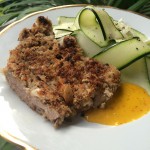First published at fishonfriday.org
It’s a grizzly Tuesday morning when I find myself in a taxi winding through London’s East End, toward Billingsgate Market. Past Rum Close, Narrow Street, Butcher Row and all the other avenues whose names hint at the rich history of this part of London’s Docklands.
“I was told by a friend of mine’s father, who was a fire warden, that the original Billingsgate building had frozen storage underground: seven storeys of compacted ice,” says the taxi driver. “After the market moved, they wanted to knock it all down, but all the ice had to be thawed out. If they did it all at once, it would have flooded London, so they had to do it bit by bit, and it’s still happening now.”
The market moved four miles east from its original riverside site on Lower Thames Street, near London Bridge, in 1982. A 32-year ice-thawing project in central London seems dubious, as the fishmongers at Billingsgate agree. But the taxi driver’s tale is typical of the glint-in-the-eye Billingsgate rhetoric: a mixture of history and tradition, entwined with myth, wishful thinking and a little arm-pulling.
It’s easy to see why the market has developed such a strong identity. A career at Billingsgate isn’t a “dip your toe in the water” affair. Fishmongers like Geoff Steadman of Chamberlain & Thelwell are fourth-generation, and many of the traders have worked at Billingsgate for half a century, with gritty claims of “never taking a single sick day”. The market has its own secret language. Traders are “bummarees”, while the rimmed hats once worn by porters to keep off the fish juice are “bobbins”. There’s even a shared market pet in the form a seal, Sammy, who circles by the dock, feasting on scraps each morning.
The distinctive yellow hanger which is the modern-day Billingsgate Market looks uninspiring from Trafalgar Way. The market was founded around 1327, and grew round London Bridge. By the 16th century the Thames hub was the centre of fish trade in London; by the 19th century, it was the biggest fish market in the world. This caused problems though as fishmongers fought against the growing traffic round one of the main routes into the City. So, in 1982, it upped and moved to a 13-acre location near Canary Wharf.
Now Billingsgate’s flat-roofed building is surrounded by acres of flat car park. Practical, but a little dull, especially in comparison to the Canary Wharf skyscrapers which tower overhead. Walk inside the market, though, and the scene which unfolds more than compensates for the lacklustre exterior: smoked fish, trays of writhing eels, and catches arriving from up and down the country, and indeed from all over the world.
Lots of the fish are so fresh, they’re not yet in rigor mortis; so fresh, that Billingsgate Market doesn’t smell of fish: it smells only of the seaside. “This is so fresh, it’s practically jumping out of the box,” says Chris Leftwich, chief inspector at Billingsgate, holding a mackerel aloft. “It should smell of iodine, not fish.”
I join Chris on his morning tour of the market, and eavesdrop on the daily chats he has with the traders, all of whom he knows by name. After working as an environmental health officer, Chris assumed his role here, appointed and employed by the Fishmongers’ Company. One of his main duties is to keep check of hygiene at the market, and make sure that everything on sale is fresh. Fish which aren’t up to standard get a big red “C” for “condemned” drawn on them. They’re withdrawn from sale, put in refrigerators and then, twice a week, collected by a specialist company who turn it into fertiliser. But nothing needs condemning today.
Chris also shows me the market’s own ice machine, which makes delicate frozen flakes that can lie across fish without bruising them. We drop by warehouses selling knives, cleaning fluids, aprons. We visit companies whisking up sushi on-site, and three catering companies which fillet the fish and send it out ready-to-cook fish straight from their warehouses. And we go to the enormous freezers which are maintained at -26°C, from which balaclava-clad workers emerge and start peeling off layer upon layer after a shift.
After a few seconds of looking around in here, the chill gets to me, so we retreat to Chris’s office, and sit down to enjoy one of Billingsgate’s biggest perks: a legendary breakfast brought up from Piggy’s market café. I devour a salty bacon-and-scallop sandwich, between mouthfuls of sugary-sweet, strong tea. And I head off to the DLR, fully fed and ready to take on the rest of the day. Meanwhile, commuters pour off the trains and hustle into the nearby offices, as their day begins.
Visitor information
Tuesday to Saturday, 4am-9.30am
15% of sales at Billingsgate Market are now to retail customers, and non-trade is welcome. Although fishmongers start arriving at 2:30, a good time to visit is 6:30-7:00am, when the market is still buzzing. Breakfasts are available in the market cafés for £5.
www.billingsgatefishmarket.org
First and second photo credit: Tim Winter (third and fourth, own shots)






Leave a Reply